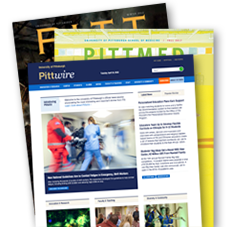Pitt Researchers Develop Technique to Clean Power Plant Mercury Emissions Using Industrial Waste as a Resource
PITTSBURGH—Today, University of Pittsburgh researchers will present a new method of cleaning up mercury emissions from power plants, using a common industrial waste product as a resource, at the 229th American Chemical Society (ACS) National Meeting in San Diego.
Mercury, a neurotoxin, is emitted in the coal-burning process and can travel for miles through the air. The Environmental Protection Agency has mandated that mercury emissions from coal-fired power plants must be controlled by 2007. Current mercury-cleanup technologies are based on injecting powdered activated carbon to adsorb the mercury, and then storing the loaded carbon together with fly ash in the ashing ponds.
Pitt professor of environmental engineering Radisav Vidic and graduate student Wenguo Feng were concerned that this method would not permanently sequester the mercury. Although the technique's effectiveness has been studied, "the problem is that most of that work is done over a short period of time," said Vidic. "This mercury is going to sit in the ashing pond for decades, and over time will just accumulate. Our concern is that it may not stay there."
Observing that mercury exists in nature as the stable compound mercuric sulfide, Vidic and Feng decided to impregnate the activated carbon with sulfur to improve its ability to sequester mercury. "These sulfur-impregnated sorbents have an enormous capacity for mercury, much higher than the raw activated carbon," said Vidic.
Next, they found that the surface of activated carbon can be used to capture hydrogen sulfide, a waste product from many industrial processes—petroleum refining, natural
gas cleanup, and coke ovens, for example ("the stinky stuff," Vidic called it)—in the form of elemental sulfur. Combining these two processes, the researchers are able to use one industrial waste product to clean up the other.
The researchers are currently investigating how to modify the hydrogen sulfide and activated carbon to be reactive towards mercury. "We hope through this project to gain additional fundamental understanding of the removal of pollutants using adsorption technology," said Feng.
Noting, "Oftentimes when we solve one problem, we create another," Vidic described his team's method as "a no-nonsense approach that will provide a long-term solution to the problem." However, he said, "It's going to require understanding on the part of regulators, utilities, the scientific community, and the public to get behind it and solve this problem once and for all, so our children will have a better environment to live in."
###
3/16/05/tmw
Media Resources
Schools of the Health Sciences Media Relations
For more information about Pitt's schools of dental medicine, health and rehabilitation sciences, medicine, nursing, pharmacy, and public health, click here >
To locate stories from health science schools prior to 2013, visit the UPMC news archives »
Urgent Question?
University of Pittsburgh news reps are available to answer urgent media inquiries. Outside of regular business hours (Mon-Fri, 8:30 a.m.-5 p.m.), please email us at media@pitt.edu.
News reps for University of Pittsburgh Health Sciences schools can be reached outside of regular business hours through the paging operator at 1+412-647-2345.


